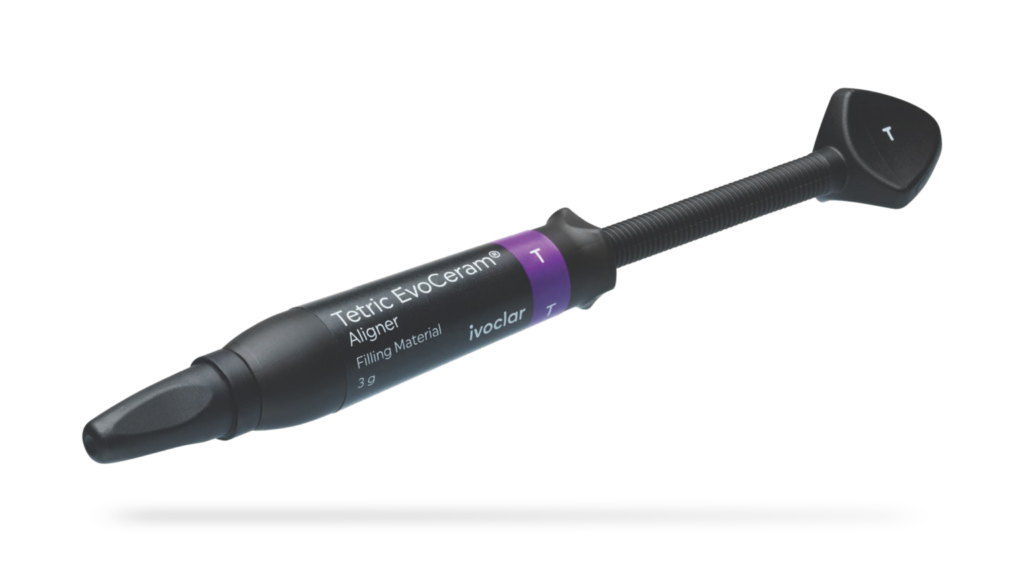
Introduction: Raising the Bar for Attachment Accuracy
Invisalign and other clear aligner therapies continue to evolve, with increasing case complexity and more sophisticated treatment goals. As a dental assistant and educator working chairside with general dentists and orthodontists, one of the most impactful clinical procedures I assist with is attachment placement. These composite buttons are essential for anchoring movements, enhancing aligner grip, and optimizing biomechanics.
But with that precision comes responsibility. Attachments must be placed with accuracy, consistency, and control to deliver the treatment outcomes patients and providers expect. That’s where Ivoclar’s Tetric EvoCeram Aligner composite, combined with a streamlined workflow and isolation protocol, elevates the standard of care.
Notably, Tetric EvoCeram Aligner is highly fluorescent, which is incredibly helpful during both the placement and removal of attachments. The fluorescence allows for easy detection of flash and leftover composite for safe and precise removal.
In this article, I’ll walk through a complete attachment protocol using Tetric EvoCeram Aligner, the OptraGate 2 retractor, Adhese Universal, Bluephase PowerCure, and OptraSculpt and OptraGloss systems to deliver beautifully bonded, long-lasting attachments that blend and perform.
Clinical Workflow & Step-by-Step Protocol
1. Isolate and Prepare

Begin by retracting the lips and cheeks with OptraGate 2. Prophy the teeth with plain pumice and rinse thoroughly. Dry and inspect each surface.
2. Etch and Bond

Apply 37% phosphoric acid to each tooth receiving an attachment. After 20 seconds, rinse thoroughly and gently air-dry. Apply Adhese Universal bonding agent, scrub for 20 seconds, air thin, and cure using the Bluephase PowerCure light.
3. Load the Template

Inject Tetric EvoCeram Aligner composite into each reservoir of the clear attachment template, slightly overfilling each to ensure complete fill and minimize voids. Use the OptraSculpt Pad instrument to precisely place and adapt the composite, ensuring optimal contour and contact.
4. Seat and Cure

Seat the template over the teeth. Hold the template in place firmly. Cure from facial angle with Bluephase PowerCure. A full cure is essential for proper adhesion and long-term durability.
5. Check for Flash

Once cured, remove the template and inspect for composite flash using a UV or black light, which makes excess material more visible. Carefully remove any flash with a carbide finishing bur. Tetric EvoCeram Aligner is fluorescent, which is critical for clear diagnostic imaging.
6. Polish and Protect

Finish all attachment surfaces using OptraGloss to refine contours and reduce friction. For added tissue protection and antibacterial benefit, apply a coat of Cervitec F varnish to the teeth.
Why Attachments Come Off: Prevention Through Protocol
Even with the right materials, attachment debonding can occur — often due to avoidable clinical missteps. Based on years of hands-on training and real-world troubleshooting, here are the most common causes and solutions:
-
- Lack of Proper Isolation: Moisture control is non-negotiable. Using OptraGate 2 provides consistent, full-access retraction and isolation, improving bonding conditions and reducing contamination.
-
- Inconsistent Adhesive Systems: For maximum compatibility and bond strength, it’s essential to stay within the same family of materials. Ivoclar’s system — including Adhese Universal and Tetric EvoCeram — is designed to work cohesively.
-
- Residual Composite and Radiolucency: When attachments do debond, the fluorescence of Tetric EvoCeram allows us to easily distinguish whether composite remains on the tooth or in the template. By shining a UV Light intraorally, we can detect subtle surface changes and confirm complete removal or identify leftover material.
A strong protocol not only prevents failures but also streamlines the re-bonding process should an attachment come off.
Conclusion: Predictability that Shows
When placing aligner attachments, consistency and invisibility matter. This workflow with Tetric EvoCeram Aligner and Ivoclar’s streamlined restorative system not only ensures strong retention but offers excellent chameleon effects and surface smoothness for patient comfort. The addition of visualization tools, such as UV light and OptraGate 2, make this system both assistant-friendly and clinically predictable.
As clear aligner cases continue to grow in complexity, a repeatable system that enhances bond strength, esthetics, and efficiency is no longer optional—it’s essential. Invisalign is a trademark of Align Technology, Inc. All other product brand names within the article are trademarks of Ivoclar.
